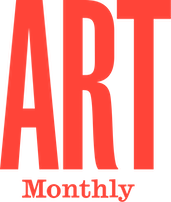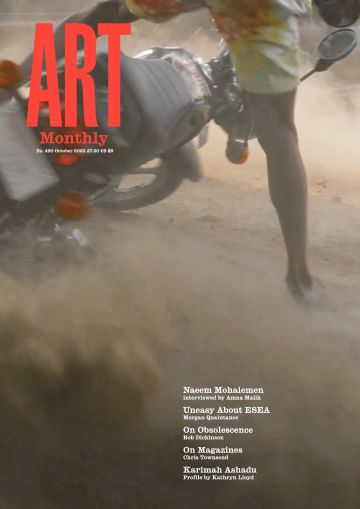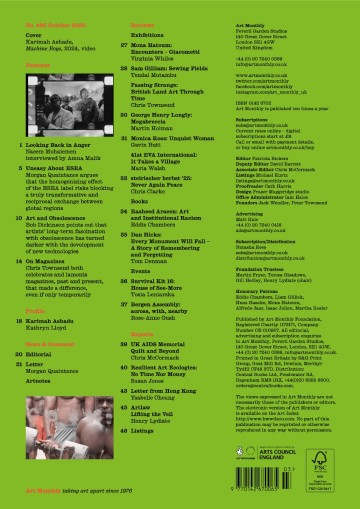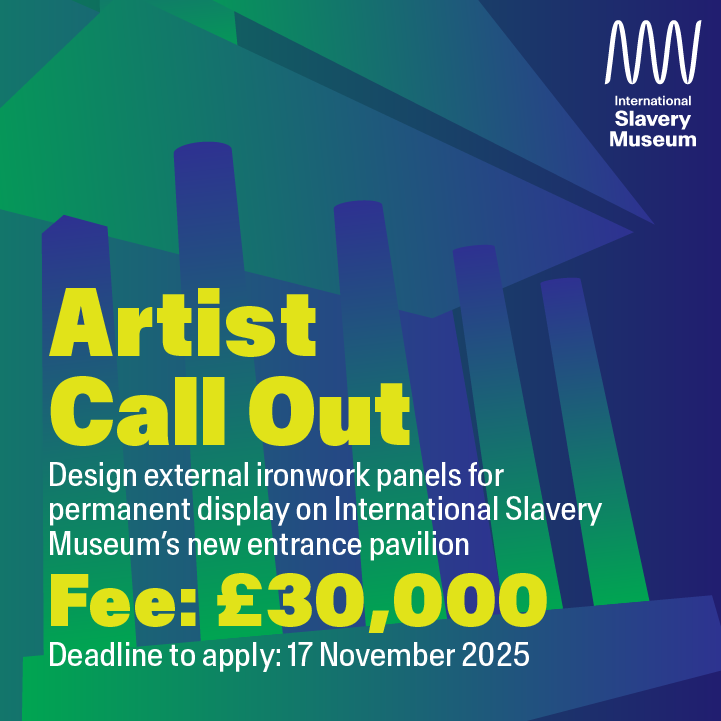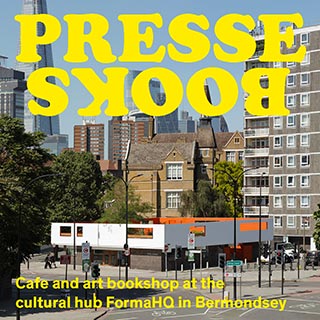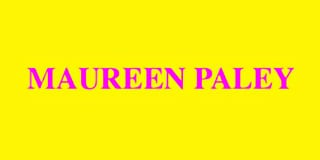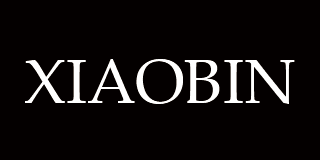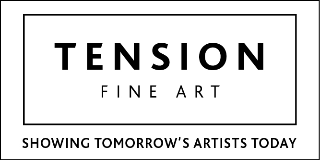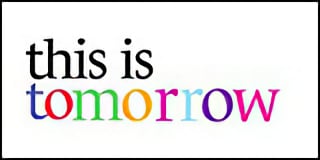Art Monthly 490
October 2025
Naeem Mohaiemen
interviewed by Amna Malik
Uneasy About ESEA
Morgan Quaintance
On Obsolescence
Bob Dickinson
On Magazines
Chris Townsend
Buy Now – select:
Want to read this right now?
Get instant access to the entire back catalogue via Exact Editions from only £8.99!
Contents
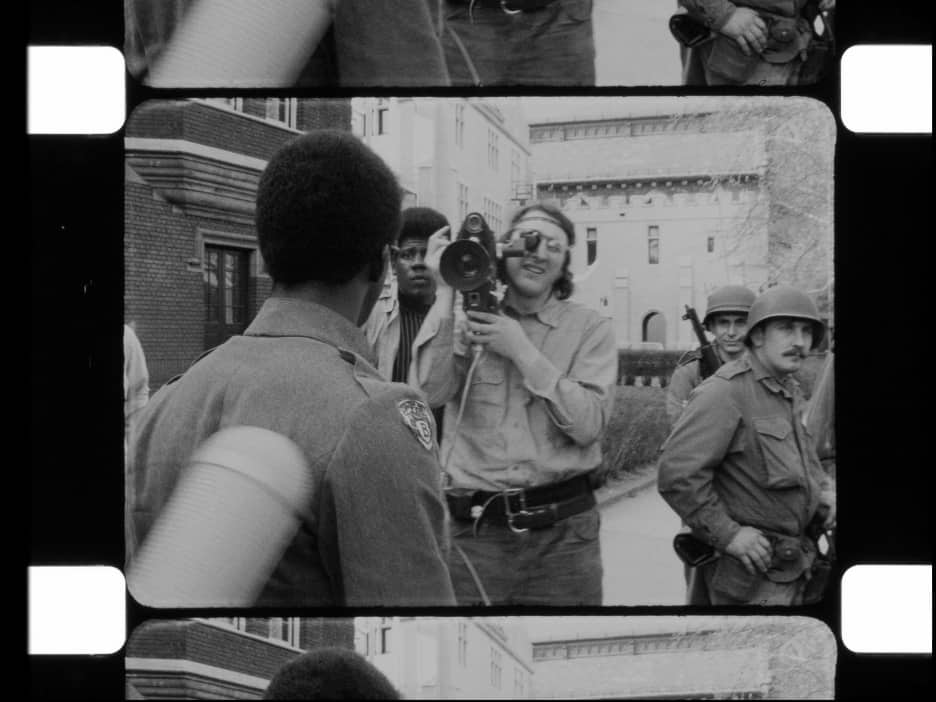
Naeem Mohaiemen, Through a Mirror, Darkly, 2025
Interview
Looking Back in Anger
Naeem Mohaiemen interviewed by Amna Malik
I asked myself why I never heard about Jackson State where, in that same month of 1970, there had been a shooting of African-American students. The two black students who died at Jackson State are not well remembered, but there is far greater awareness of the fatal event around the deployment of the National Guard around the Kent State protests.
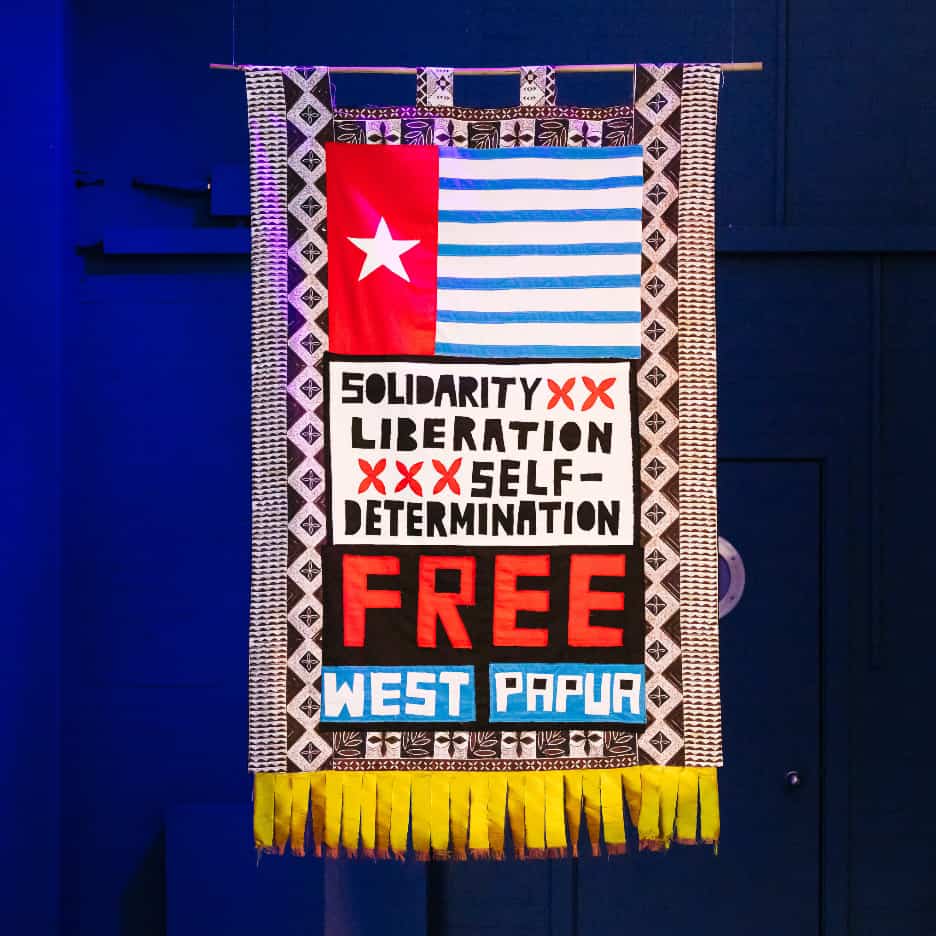
Momoe i manu ae ala atae’e Tasker, Protest banner for West Papua, 2024
Feature
Uneasy About ESEA
Morgan Quaintance argues that the homogenising effect of the ESEA label risks blocking a truly transformative and reciprocal exchange between global regions
The central flaw of binary models, which are used in geographical and community-based distinctions to cast the West as negative other, is that they come bundled with a strange Manichaean moral imperative. That is to say, the body defining itself against the West must be made to stand for almost everything that the West is not.
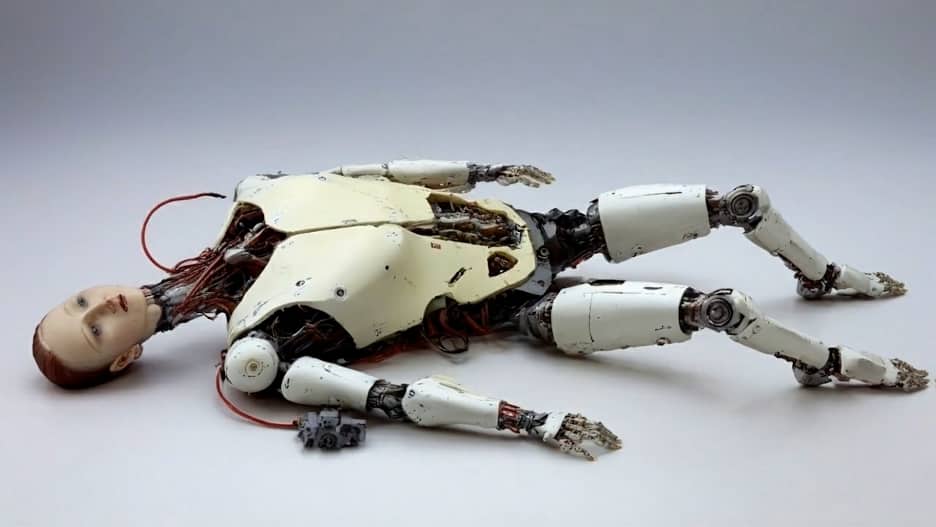
Aisling Phelan, Goodbye Body, 2025
Feature
Art and Obsolescence
Bob Dickinson points out that artists’ long-term fascination with obsolescence has turned darker with the development of new technologies
Perhaps a deeper understanding of obsolescence can change the experience of art itself, creating glimpses of what appears to be a parallel world in which it is possible for obsolescence to contain possibility.
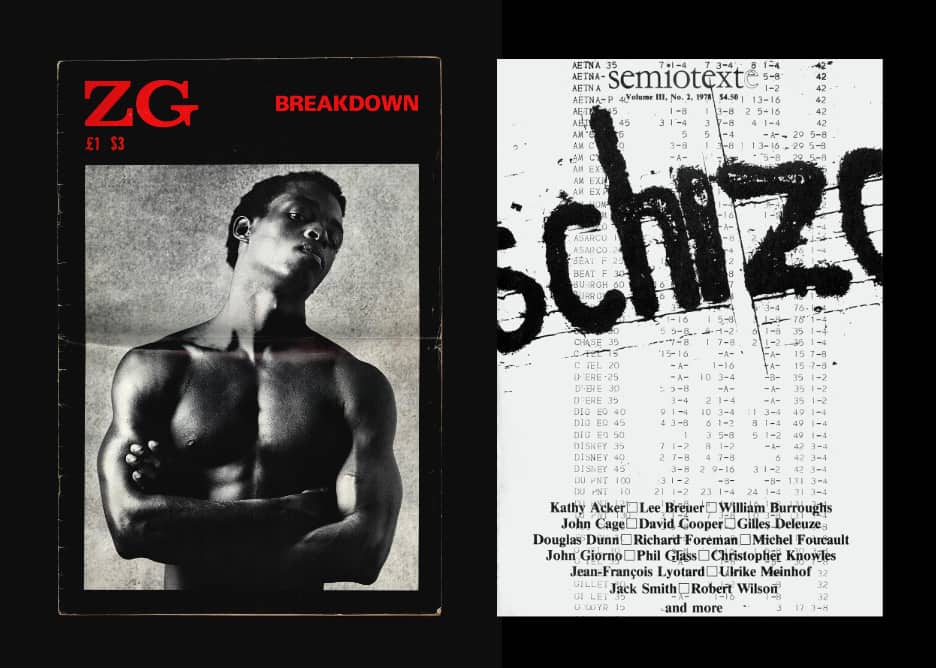
ZG and Semiotext(e) magazine covers
Feature
On Magazines
Chris Townsend both celebrates and laments magazines, past and present, that made a difference, even if only temporarily
Gary Indiana’s praise for ZG and Wedge would be an epitaph, as neither lasted beyond the mid 1980s. That extinction might be because these publications had done their work in highlighting art’s connections in the transformed historical field of neoliberalism or, maybe, as usual, money, death and power won out.
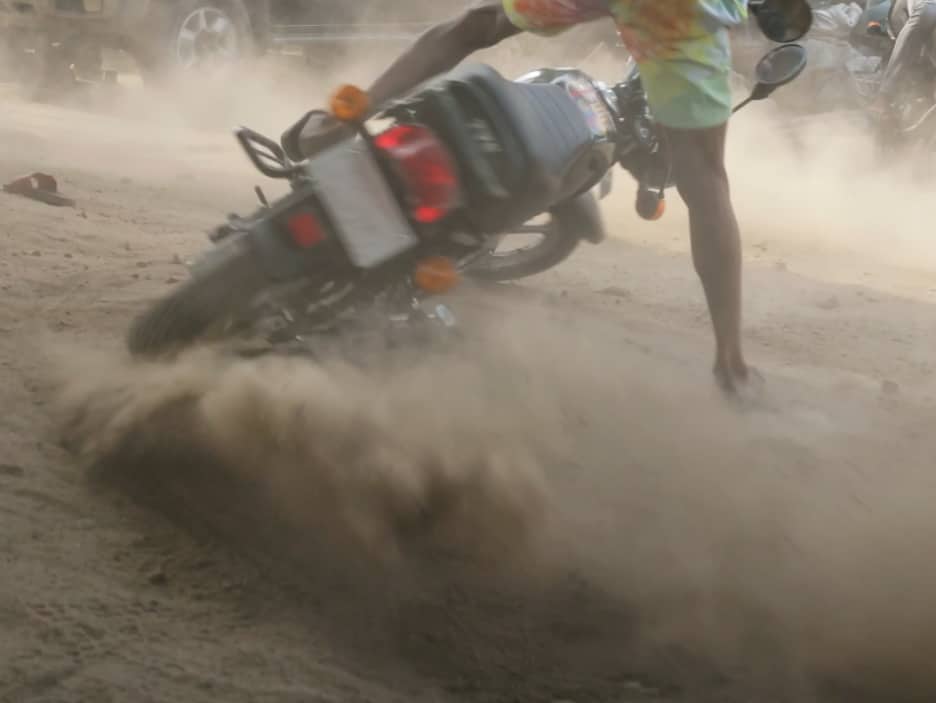
Karimah Ashadu, Machine Boys, 2024
Profile
Karimah Ashadu
Kathryn Lloyd
Machine Boys captures a group of young men who operate illegal motorcycle taxis in Lagos, known locally as okadas. Many of the riders stare directly out at the viewer before veering off abruptly or creating endless burn-out circles that churn up clouds of dust, as though responding to a shared internal choreography.
Editorial
Flag Waving
England’s self-confidence used to ensure that flag waving was reserved only for state pageantry, but recent insecurities – preyed on by xenophobic nationalists – have caused an outbreak of flags which is spreading across little England like a rash.
In the postwar years, nationalist politicians on the right who wrapped themselves in the Union flag were generally ridiculed, while those on the internationalist left, which cleaved to the red flag, routinely denounced them as fascists.
Note on Magazines
This is Art Monthly’s 490th issue and, as we begin the countdown to our 500th issue and 50th anniversary in October 2026, Chris Townsend’s feature ‘On Magazines’ gives us pause.
Some magazines are intentionally ephemeral, others are like shooting stars that burn out but leave an indelible trace; some founder or peter out and some transform themselves to stay current without losing their identity or try, as we say at Art Monthly, to stay the same while changing utterly.
Letter
Continuing the Conversation
Morgan Quaintance responds to Dave Beech’s feature ‘Talking in Class’
Of the raft of stellar points in Dave Beech’s ‘Talking in Class’, this one stood out: ‘the only way to reformulate class theory for the 21st century is to keep talking’. In that spirit I’d like to elaborate on an important aspect of class consciousness that Beech also cited in the opening of his text: the notion of solidarity.
Artnotes
Ethics in Culture
The Museums Association updates its Code of Ethics to proscribe sponsorship from the fossil fuel industry; Parliament debates banning advertising and sponsorship by the fossil fuel sector; a new scheme launches that encourages artists to support climate initiatives; a pay survey in the arts sector reveals the challenges that working-class artists in particular suffer; the Israeli government defunds its national film awards after the top prize was given to a collaboration between Jewish and Palestinian filmmakers; Christie’s shutters its Digital Art department after disappointing sales; plus the latest on galleries, people, awards and more.
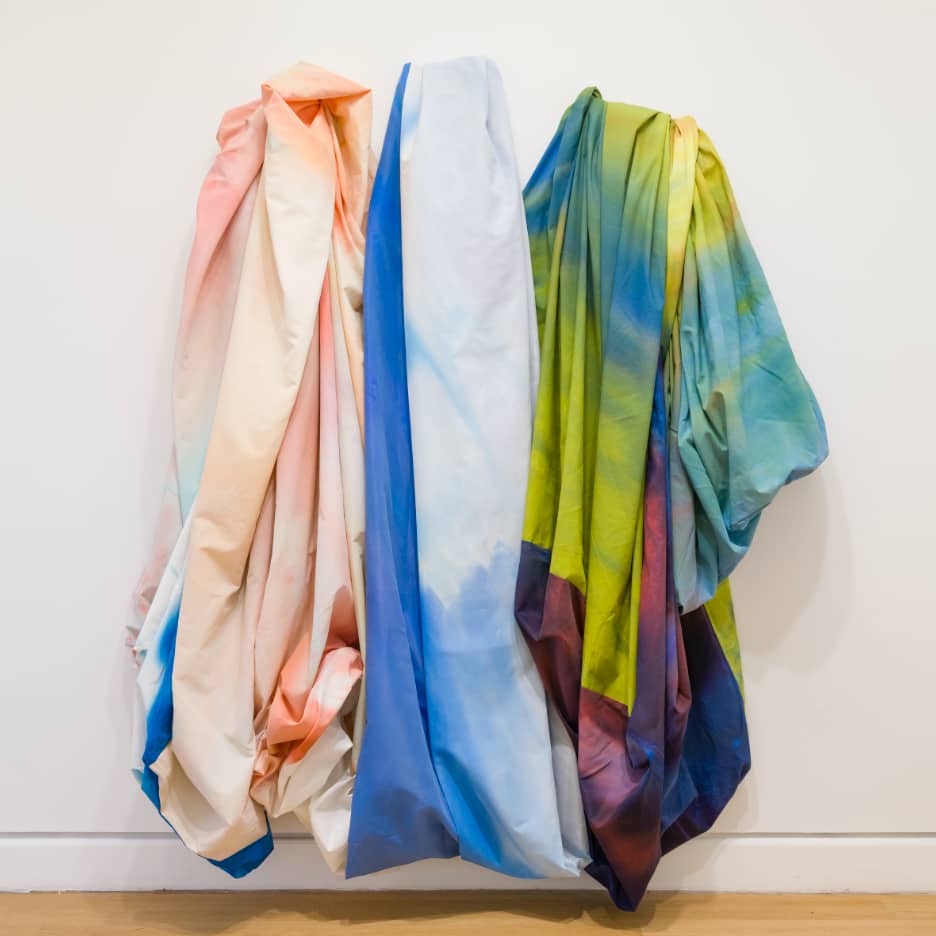
Sam Gilliam, Count on Us, 2008, IMMA, Dublin
Exhibitions
Mona Hatoum: Encounters – Giacometti
Barbican, London
Virginia Whiles
Sam Gilliam: Sewing Fields
IMMA, Dublin
Tendai Mutambu
Passing Strange: British Land Art Through Time
Henry Moore Institute, Leeds
Chris Townsend
George Henry Longly: Megabreccia
White Chapel Somerset, Langport
Martin Holman
Monica Ross: Unquiet Woman
Phoenix Art Space, Brighton
Gavin Butt
41st EVA International: It Takes a Village
various venues, Limerick
Maria Walsh
steirischer herbst ’25: Never Again Peace
various venues, Graz
Chris Clarke
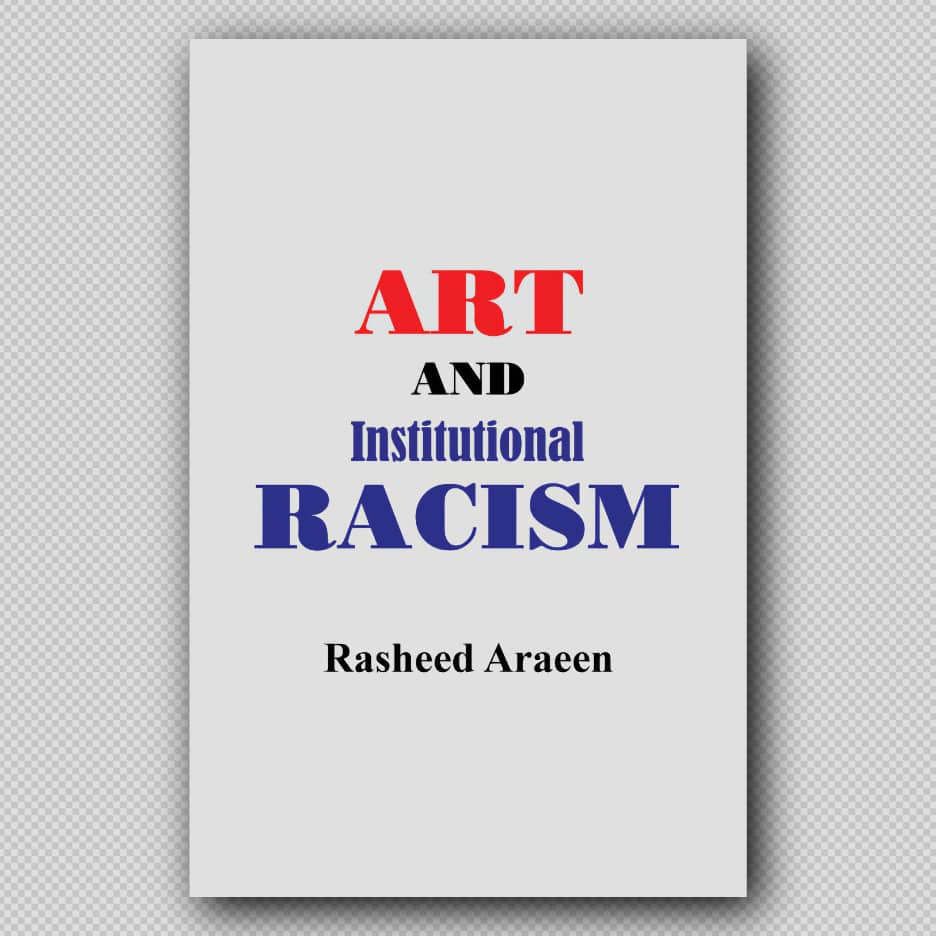
Rasheed Araeen, Art and Institutional Racism
Books
Rasheed Araeen: Art and Institutional Racism
Eddie Chambers
The book’s essays are in large part Rasheed Araeen’s recollections of interactions and conversations with senior figures in galleries and funding bodies from which he sought support. Sometimes the recollections are as he remembered them; in other instances, though, Araeen’s recollections take the lengthy form of reproduced email exchanges with senior figures such as Tate’s Nicholas Serota and the Courtauld’s Deborah Swallow.
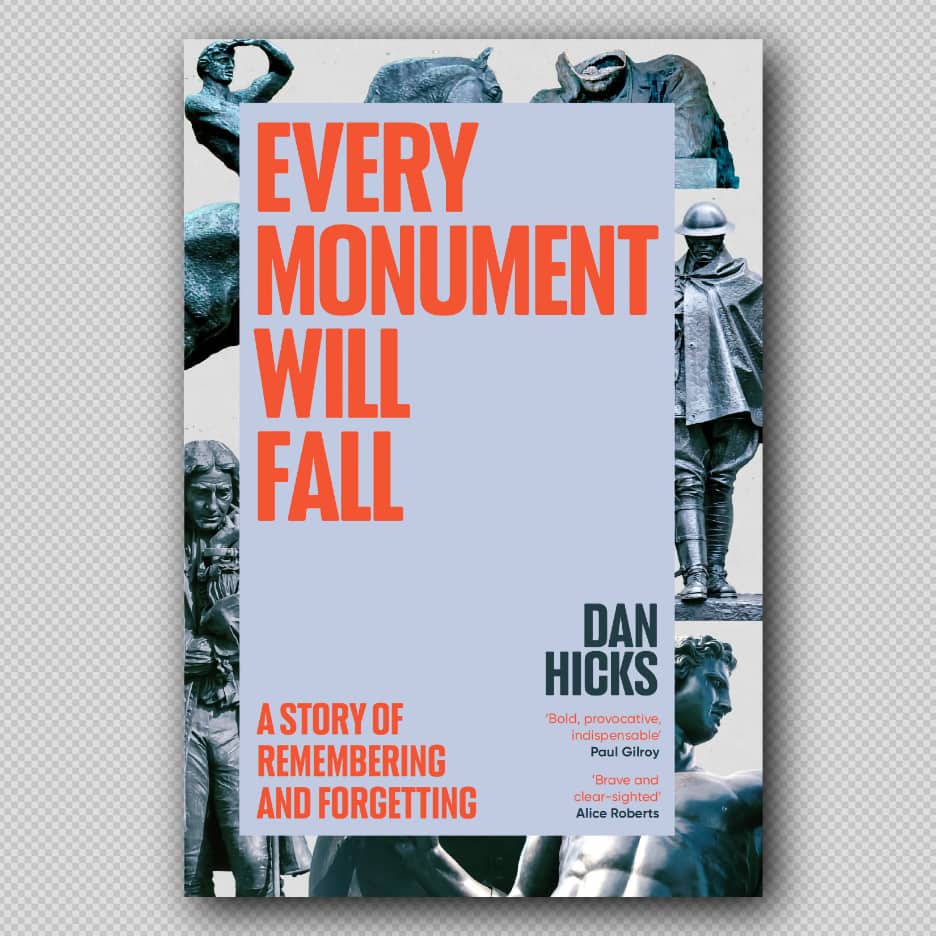
Dan Hicks, Every Monument Will Fall
Books
Dan Hicks: Every Monument Will Fall – A Story of Remembering and Forgetting
Tom Denman
One of this book’s main strengths is its expansive definition of monumentality. Sustained by whataboutism as well as quieter forms of wilful ignorance, victimising memorialisation seeps surreptitiously into the material culture of power and all that surrounds it.
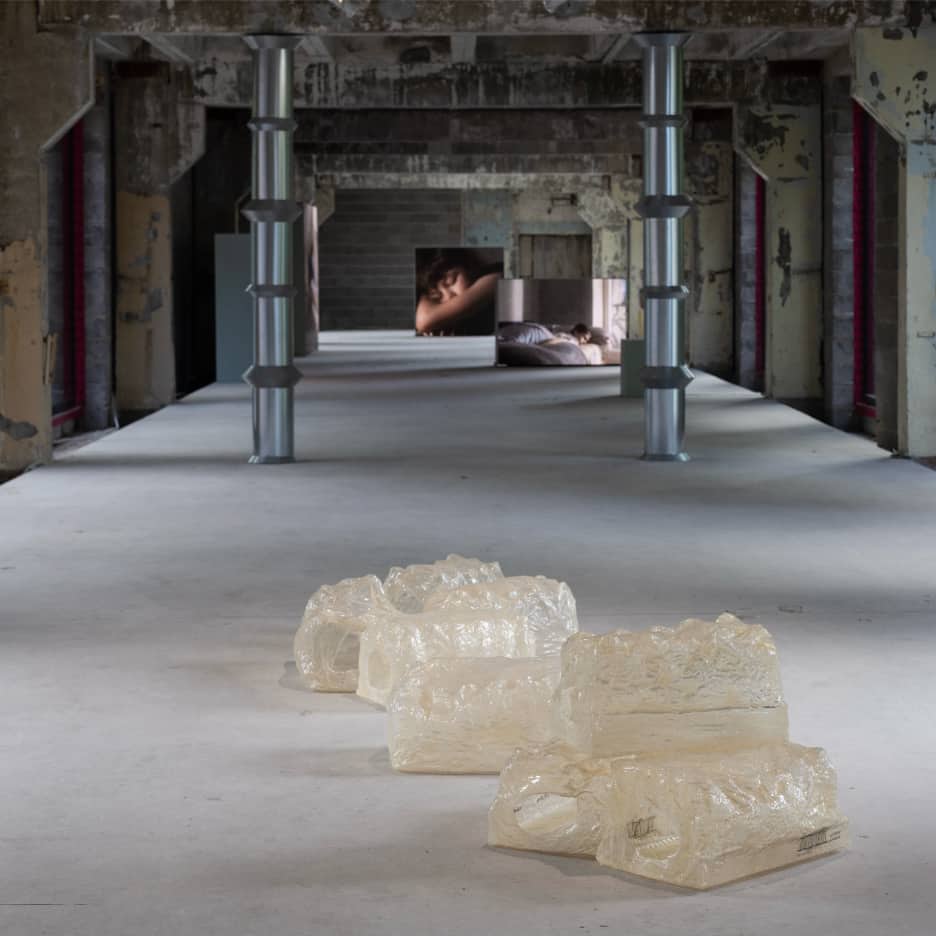
Shadi Habib Allah, In Stock, 2018
Events
Survival Kit: House of See-More
Tosia Leniarska
Palestinian artist Shadi Habib Allah’s ghostly husks of glistening plastic water bottle packaging are taken from food deserts in urban Detroit, sites where the only grocery shops for the local underserved black communities have been opened by Arab immigrants – refreshingly, the only instance of the US being mentioned in the exhibition.
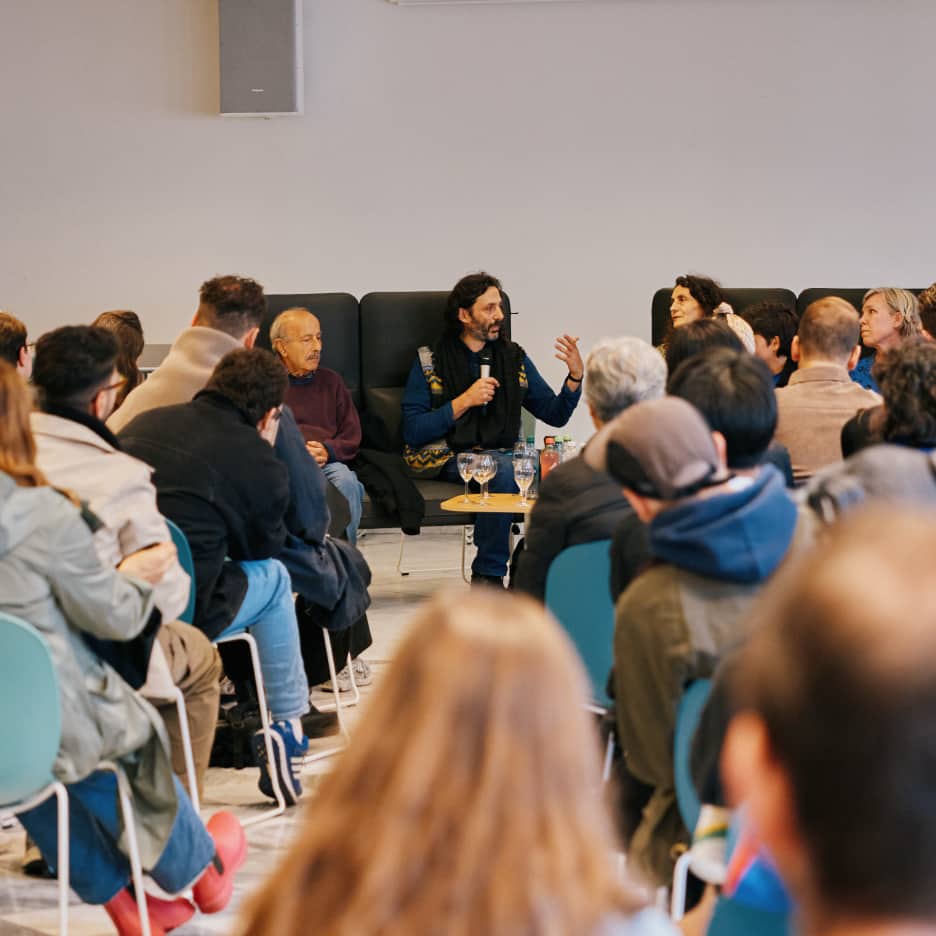
conversation hosted by Tenthaus Art Collective at the Communist Museum of Palestine
Events
Bergen Assembly: across, with, nearby
Rose-Anne Gush
While many cultural and art institutions have capitulated to political pressure and censored staff, students and invited artists – or, at best, forced them to bury their political speech in euphemisms – it is notable that Bergen Assemby, an international art event, has put Palestine front and centre, finding ways to link it to other sites of struggle, including the incarcerated and continuing issues of land rights.
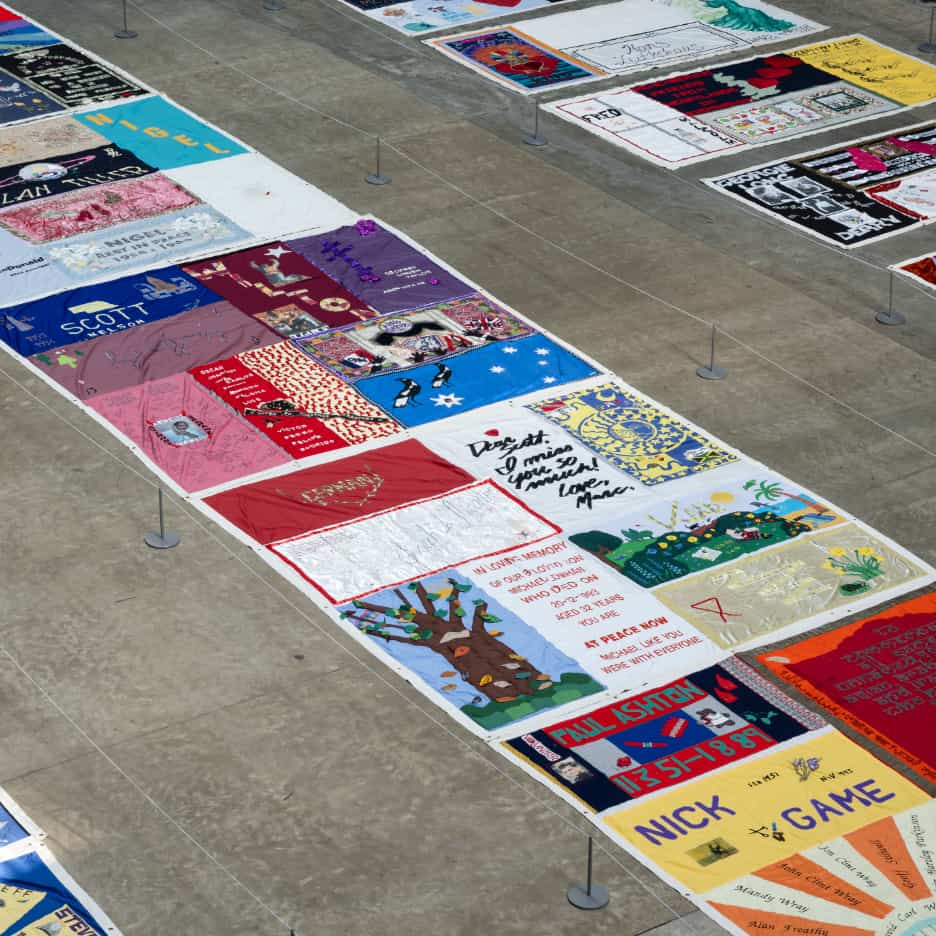
UK AIDS Memorial Quilt at Tate Modern
Report
UK AIDS Memorial Quilt and Beyond
Chris McCormack
For many, the quilts unquestionably gave them the right to grieve what were often ungrievable deaths: lives that often were subsumed into more societally tolerable visions, funerals where the person’s queerness was expunged, or whose death was often redescribed as being from cancer, mollifying the needs of a family’s so-called wishes.
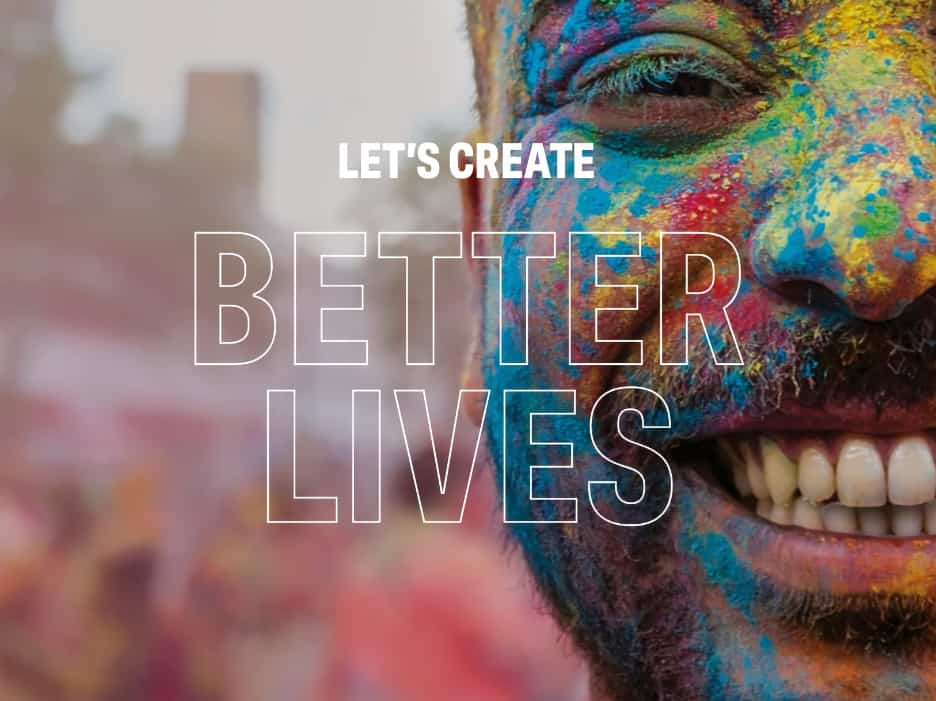
promotional image from ACE’s 2020–30 ‘Let’s Create’ strategy
Reports
Resilient Art Ecologies: No Time Nor Money
Susan Jones
Arts policies have, over time, marginalised the position of artists within the infrastructures and wider ‘ecology’ of the arts. As a result, artists at all development stages now lack social status, putting them at a disadvantage when negotiating with art’s administrators.
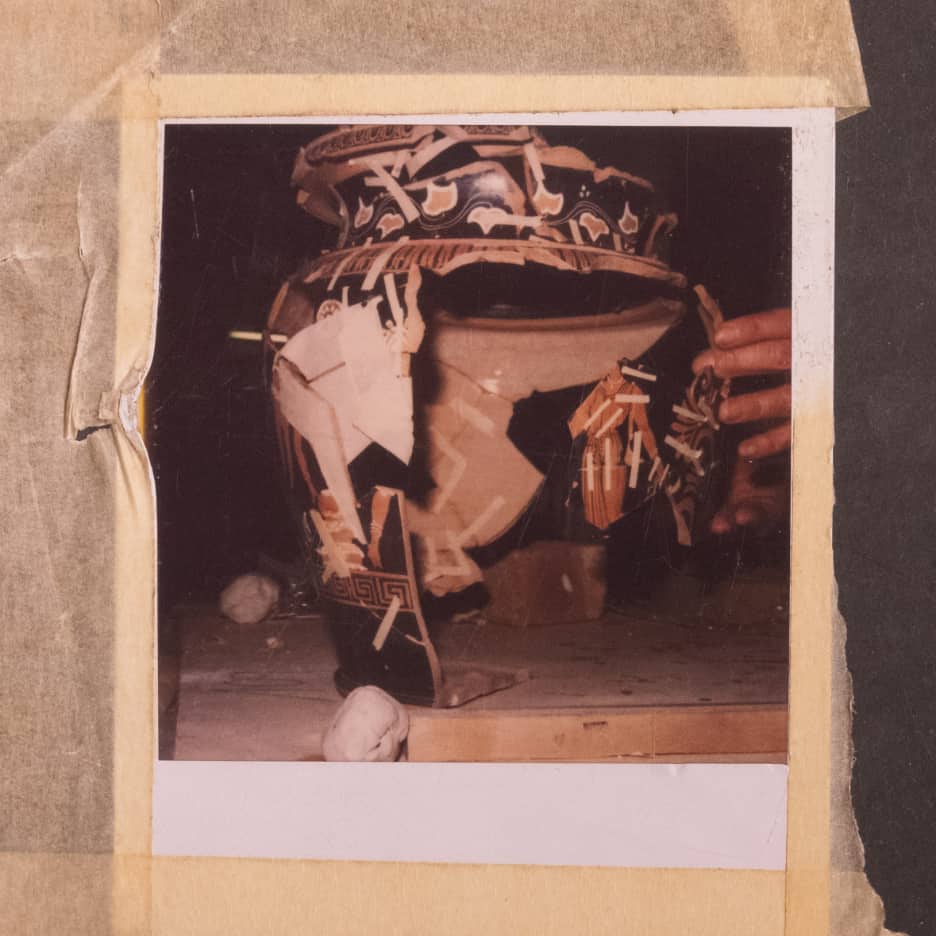
Maeve Brennan, Box 29_01, 2022, detail
Reports
Letter from Hong Kong
Ysabelle Cheung
While nostalgia itself isn’t inherently problematic, its tendency toward romanticisation can be, washing over the more complex and ambiguous stories of our past.

promotional image for the BBC’s ‘The Great Art Fraud’ documentary
Artlaw
Lifting the Veil
Henry Lydiate
In the UK, a limited liability company dealership currently faces challenges from artists who allege they are owed payment for sales of their consigned works while some collectors demand repayment for purchases of works they are yet to receive. Lawsuits may be filed against the company and/or, if there are valid grounds for its corporate veil being lifted, the owners personally.
